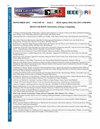IoT-based Environmental Monitoring and Prediction of Banana Moisture Content in a Solar Greenhouse Dryer
IF 1.3
4区 工程技术
Q3 COMPUTER SCIENCE, INFORMATION SYSTEMS
引用次数: 0
Abstract
Modernizing the drying process will reduce agricultural product waste and environmental pollution. The aim of this study was to design a monitoring system based on the internet of things (IoT), temperature and relative humidity for a solar dryer. This system consists of a data collection module that gathers data regarding temperature (Ta), external relative humidity (RH) and on/off time of the solar dryer exhaust fans; a communication module that transmits Ta and RH information via LoRa and Wifi to ThingSpeak for monitoring on a mobile device; and a power module providing electrical power for system operation by solar energy. The operation of the IoT monitoring system was evaluated in three drying experiments of Dominican bananas (Musa paradisiaca var sapientum), in which system performance was satisfactory, allowing the user to visualize graphically in a web and mobile interface the behavior of Ta and RH inside the dryer. The data measured by the system were used to predict banana moisture content with an autoregressive model with exogenous variables (ARX) identified online. The mathematical model found predicted the behavior of moisture content with a good goodness of fit, with values of R2 = 0.99, MSE = 1.2910-5 and MAE = -5.0310-6. The solar dryer allowed reducing the moisture content of bananas up to 19.84 % wet basis (w.b.) in a period of 4 days and by 20.03% w.b. for 5 days in the presence of rainfall.基于物联网的环境监测以及太阳能温室干燥机中香蕉水分含量的预测
干燥过程的现代化将减少农产品浪费和环境污染。本研究的目的是为太阳能干燥机设计一个基于物联网(IoT)、温度和相对湿度的监控系统。该系统包括一个数据收集模块,用于收集有关温度(Ta)、外部相对湿度(RH)和太阳能烘干机排风扇开/关时间的数据;一个通信模块,用于通过 LoRa 和 Wifi 向 ThingSpeak 传输 Ta 和 RH 信息,以便在移动设备上进行监控;以及一个电源模块,通过太阳能为系统运行提供电力。在对多米尼加香蕉(Musa paradisiaca var sapientum)进行的三次干燥实验中,对物联网监控系统的运行情况进行了评估,系统性能令人满意,用户可以在网络和移动界面上以图形方式直观地看到干燥机内的温度和相对湿度的变化情况。系统测量到的数据被用来预测香蕉的水分含量,该预测是通过在线识别的外生变量自回归模型(ARX)得出的。所发现的数学模型能很好地预测水分含量的变化,拟合度为 R2 = 0.99,MSE = 1.2910-5 和 MAE = -5.0310-6。太阳能干燥机可在 4 天内将香蕉的湿基含水量降低到 19.84%,在降雨的情况下,5 天内可将湿基含水量降低 20.03%。
本文章由计算机程序翻译,如有差异,请以英文原文为准。
求助全文
约1分钟内获得全文
求助全文
来源期刊

IEEE Latin America Transactions
COMPUTER SCIENCE, INFORMATION SYSTEMS-ENGINEERING, ELECTRICAL & ELECTRONIC
CiteScore
3.50
自引率
7.70%
发文量
192
审稿时长
3-8 weeks
期刊介绍:
IEEE Latin America Transactions (IEEE LATAM) is an interdisciplinary journal focused on the dissemination of original and quality research papers / review articles in Spanish and Portuguese of emerging topics in three main areas: Computing, Electric Energy and Electronics. Some of the sub-areas of the journal are, but not limited to: Automatic control, communications, instrumentation, artificial intelligence, power and industrial electronics, fault diagnosis and detection, transportation electrification, internet of things, electrical machines, circuits and systems, biomedicine and biomedical / haptic applications, secure communications, robotics, sensors and actuators, computer networks, smart grids, among others.
 求助内容:
求助内容: 应助结果提醒方式:
应助结果提醒方式:


